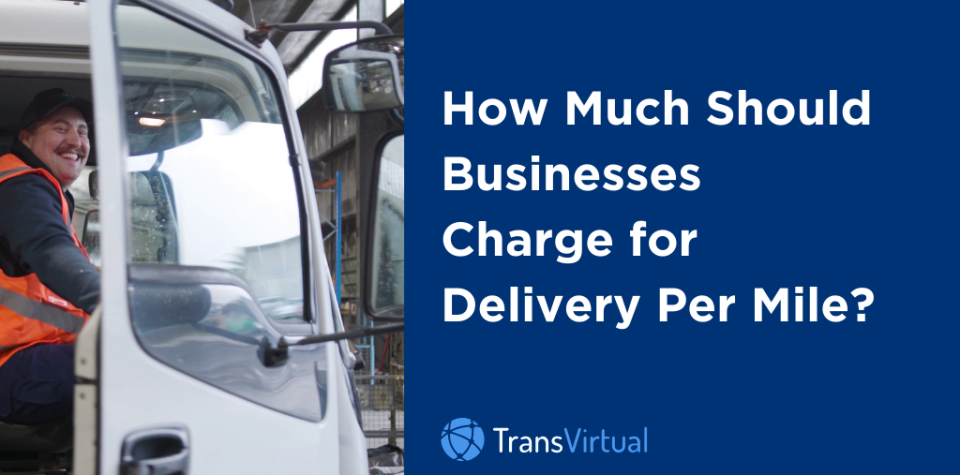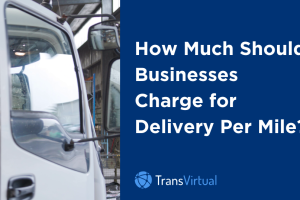Table of Contents
To charge or not to charge?
Delivery costs are not the most glamorous aspect of running a delivery business, but determining your rates is an important part of making sure that you remain profitable. There are a few different approaches to this issue, and today we’re breaking down one of the most common and effective ways in which transportation companies charge their clients: charge per-mile delivery.
(And, just to preface, we’re going to be using the term per mile because it’s more well-known, but most Aussie companies will charge by the kilometer)
But what exactly is charging per-mile delivery and how does it help your delivery operations?
In this article, we’ll discuss what charge per-mile delivery means, why it’s used, and the factors that can influence the rate you charge.
There’s heaps to cover, so let’s get into it.
What are Delivery Fees Per Mile?
‘Charge per mile’ delivery is the specific method delivery businesses use to calculate their rates. These companies take into account the overall delivery expenses, and use it to determine a set rate, which is multiplied by the number of miles travelled to complete a delivery to determine the amount clients must pay.
The formula for calculating a delivery charge per mile looks like this:
Rate x Miles / Kilometres Travelled = Total Cost per mile
For instance, a delivery driven the 910km from Sydney to Brisbane at a rate of $2/km would result in a total charge of $1820.
In some cases, businesses charge a flat rate on top of this, but the principle is generally the same.
Why do businesses charge per mile?
Charging per mile is seen by many businesses as an easy and intuitive way to scale their delivery pricing according to the cost and effort required for each different delivery.
This is because each mile travelled uses up a certain amount of fuel (give or take) and a certain amount of time that the driver spends on delivery, which translates directly into a business’ labour and fuel costs. These costs multiply themselves with every mile travelled, making charging per-mile an easy way to scale up the price of a shipment depending on fuel and labour costs.
Why this might be right for your delivery service
Charging per-mile is popular for a reason, and can offer many benefits to businesses. It is also considered a cost effective delivery method, ensuring that businesses can maximize their profits while maintaining competitive pricing.
Here are a few reasons why charging per-mile might be right for you:
Scaled to the Job
For companies that deliver to a range of customers over a range of distances, a per-mile rate is automatically scaled to the size of the job. Compared to a fixed pricing model, this ensures that rates are accurate, no matter the length of the journey.
Minimal Hassle
Fixed rates often need to be calculated per client, or businesses run the risk of the numbers not adding up. This means that fixed rates, if they’re done right, can incur extra expenses and hassle in the form of administrative labour. Charge-per-mile pricing generally operates on a standardised basis – freeing up more administrative time.

Why it might be wrong for calculating the costs of delivery jobs
However, there are a number of factors that may mean charging per mile isn’t the ideal choice for your delivery business, and many companies instead choose to charge a minimum delivery fee for their shipping, which differs depending on the client.
These factors include:
Specialty Clients
As we’ll get into in our next section, it’s very common for businesses to factor additional operational costs (aside from just fuel cost and labour) into their per-mile rate. However, when a client requires an extremely specialised service with a lot of variable costs, it can become increasingly convoluted to factor these services into a per-mile rate.
Small Distances
Companies that only deliver goods over small distances may find that a per-mile delivery rate doesn’t factor in the effort required to get a shipment on the road, or find that having to charge absurdly high per-mile rates is off-putting for potential customers.
Factors for determining your cost per mile
One of the largest takeaways about charging-per-mile is that the rate needs to factor in the particular costs associated with your business, including the average delivery cost and the average market value in your area. Two companies may even use the exact same make and model of truck, but charge very differently for their delivery services.
Below, we’ve compiled some of the major factors that should influence the price you charge per-mile.
Location, Location, Location
The locations between which you need to travel also make a difference in terms of fuel usage.
Many companies charge a higher per-mile rate when delivering to or within urban areas, as the need for constant idling, acceleration and braking can result in higher fuel usage per mile travelled. For example, a trip from Sydney to Canberra can have lower fuel usage per mile than a trip from Bondi Beach to Western Sydney.
Hourly Rates
Your drivers’ hourly rates (and overtime rates for after hours orders) are another important factor in determining your rate. By nature, if you’re paying your drivers a higher rate then you’ll need to raise your per-mile charges in order to cover the extra labour costs. Make sure to also factor in if drivers will be entitled to penalty rates, and charge accordingly. In a courier service business, delivery drivers’ wages are a significant factor in determining overall costs.
Specialised Equipment or Handling
Some goods require more labour and equipment than others to transport, which should be reflected in your price. A shipment of tennis balls likely needs less attention than a shipment of wine glasses. Additionally, vehicle cost and vehicle maintenance are essential expenses that must be factored into your pricing model.
Heavy or Bulky Packages
Heavier and bulkier shipments require more packing and handling time and require more fuel to transport. Charging a surcharge for overweight packages can recover some of these costs. You can decide when it’s appropriate to add this extra charge: depending on the size of your operation, this might kick in at 5 or 50kg overweight.
Time of Delivery
As much as customers have grown accustomed to delivery services that are truly on-demand, it pays to remember that you have the right to charge more for deliveries occurring in unusual hours, public holidays, or rush periods such as the Christmas season.
Part of this relates to the extra labour costs of making deliveries whilst your drivers are on penalty rates, as well as the extra organisational labour required to coordinate deliveries during peak periods.
Some companies deal with this by applying a flat surcharge to their rates, which hopefully evens out to cover extra expense, whereas others prefer to do the maths and work out the extra costs required. Both approaches are valid, and the one that will work best depends on the amount of time and labour you’re willing to devote to absolute accuracy.
Ready to Improve Your Delivery Costs?
Managing your rates and accounting in one place is a game changer for any business looking to take better control of their financial position. With all this in mind, take a look at TransVirtual’s free trial to see what we can do for your business today.



